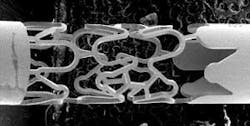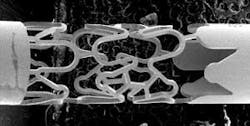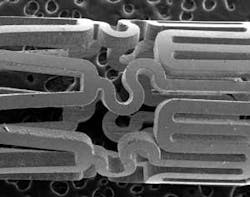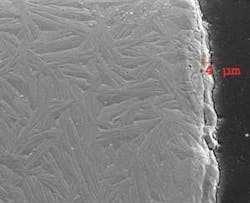Gaining momentum
Fiber lasers are challenging traditional laser types in many applications, including stenting
Anthony Hoult
It is an interesting time in the laser industry. For some years, the choice was simply CO2 or Nd:YAG and some very specialized excimer applications.
Now we have a wealth of choices; there are indeed several types of low- and high-power CO2 lasers from which to choose. Flashlamp- and diode-pumped solid-state lasers have now almost divided up their applications space, with some lasers getting down to high peak power nanosecond pulses. More specialized pico- and even femtosecond lasers are becoming commercially available for micron and even sub-micron scale processing. Excimer lasers on the other hand have expanded their power levels up to the 300-watt level. Another solid-state laser development, disc lasers are now available across the full power spectrum. However, none of these lasers have created quite the interest as fiber lasers.
Fiber lasers burst onto the industrial laser scene several years ago as a result of technology developments in the telecom industry. With the downturn in that industry in early 2000 only a few organizations were in a position to utilize this technology at higher average powers for real industrial laser applications. Many observers expected more competition to be announced during last year’s Munich laser show but none have yet emerged to challenge the two now established suppliers in this market. These companies are bringing new technology and introducing new business models into the industry.
Conventional lasers are now well established in their respective market niches. For each application, specialized processes have been developed and each laser manufacturer has expended a great deal of time and effort in developing these. It is our view that, to successfully break into these established applications, the relevant process expertise needs to be known. A customer is not going to buy a laser unless it knows the laser will do the job and knows the laser manufacturer understands its particular problems and is able to respond appropriately. Therefore laser applications laboratories are a crucial part of the sales process as is a ‘try before you buy’ evaluation program. Although fiber lasers have many advantages over conventional lasers, there are no easy sells. Each application and each customer has to be addressed individually. Often, it is not enough to simply match existing performance; customers often expect a significant increase in performance to justify the purchase of new equipment.
These comments are particularly true in the field of low-power fiber lasers, up to 200 watts average power, where SPI Lasers are now well-established suppliers of industrial fiber lasers. New models are now being launched and with dramatic progress.
Underlying the rapid development of the fiber laser is its inherent simplicity; the laser beam is emitted from a long, thin, easily cooled fiber, and this is pumped by highly reliable and efficient single-emitter diodes. It must be noted that it is much easier to control solid-state diodes than it is to control flashlamp pulses. Although a great deal of expertise and development has been put into the GT Wave fiber concept, controlling of diode lasers and hence the laser beam is done using well tried and tested microelectronics.
To illustrate the progress that fiber lasers are making, this article covers the applications where fiber lasers are challenging conventional lasers particularly hard; in the laser microprocessing regime at the 100W power level. Two of the most challenging real applications in this area are stent cutting and solder mask stencil cutting. In both of these applications, the significantly higher brightness of the fiber laser is a useful starting point in any laser comparison. Using what have become standard off-the-shelf laser machining heads, fitted with high quality 50mm focal length lenses, and even without any beam expansion, focused spot sizes below 15 microns have been measured. This translates to a kerf width of 25 μm, straight out of the box with no beam expanding optics required.
Stenting is a procedure in which a small-diameter tube is laser cut into a very fine wall wire mesh-like structure. This structure is inserted within arteries to allow oxygen-rich blood to flow to keep arteries open and also to compress plaque to prevent strokes. Different types of stents are used for different areas within the body, but stenting now offers a less invasive way to treat arterial diseases. It has been shown that the procedure is safe and effective for patients who do not have symptoms (preventative stents); those who have greater than 80 percent blockage of the carotid artery; and those who are at high risk for surgery.
The reliable cutting of large production volumes of these devices has challenged laser manufacturers and systems builders. Important improvements were needed in tooling, motion systems, and part feeding, and techniques were also required to prevent back wall damage on these thin wall (0.012-inch) small diameter (0.08-inch) tubes. A number of specialized systems integrators have been supplying stent cutting machines now for some years. Most of these integrators have now realized the benefits of fiber lasers in this application, which can be summarized as follows:
- Overall running costs are significantly reduced (see ROI for stent cutting with fiber lasers).
- Fiber lasers can produce low-taper, high aspect ratio cuts with little process optimization.
- When compared with solid-state Nd:YAG lasers, kerf width, cut taper, and recast layer thickness can all be significantly reduced.
- There is an important improvement in the controllability of the cut due to the ability to freely modulate the pulse frequency and pulse duration. This is particularly important when cutting complex shapes into very thin-walled components with very sharp radii, as shown in Figure 3.
- Cut speeds of up to 0.8 IPS, an improvement of a factor of four, have been demonstrated by stent manufacturers.
- These lasers are operated from plant electricity, with a minimum of water cooling requirements.
- Pumping with single-emitter diode lasers leads to very long lifetimes
- The footprint of a fiber laser is significantly smaller than that of a solid-state laser, thus saving costly cleanroom space; three fiber lasers can fit into the floor space of a single solid-state laser.
All of the three main material types used for stents-stainless steel, cobalt chrome (MP 35N), and Nitinol (nickel titanium superplastic alloy)-can be successfully cut with fiber lasers. Visual observations of cut quality have been confirmed and enhanced by SEM examination of sections of laser cut thin-walled tubes at high magnification (see Figure 2).
A high-quality precision laser machining head is required with a multi-element 50mm focal length lens. It has been shown that to take advantage of the high brightness of the fiber laser, all other aspects of the laser process also need to be tightly controlled. This applies to process details such as nozzle-to-workpiece stand-off distance, which is reduced to 0.01 inch. High assist gas pressure is required, usually in the range of 120 psi. Oxygen is widely used as an assist gas for stainless steel and cobalt chrome but not for Nitinol materials. Wet cutting is used by some systems integrators; in this case a water jet is passed through the tube during laser cutting to minimize heat input to the part and hence minimize the creation of a recast layer. The brittle nature of this recast layer means that it must be completely removed by post processing of the laser cut part, and a great deal of effort is put into this etching process. There is, therefore, a big incentive to create as little recast layer as possible during the laser cutting process.
Typical laser cutting parameters used are, in fact, quite similar to those used by a flashlamp-pumped solid-state laser, typically between 1-2 kHz and a pulsewidth of 10 microseconds.
It is now clear that fiber lasers are here to stay. Where focusability is required, fiber lasers outperform all other laser types. They are now matching or outperforming conventional lasers in almost every materials processing application in which near-infrared lasers compete. Additionally, the intrinsic stability of fiber lasers reduces scrap costs. Parameter flexibility and lack of thermal lensing lead to simple process development. In fact, as more data becomes available on long-term reliability and running costs, fiber lasers are expected to dominate certain applications segments.
Dr. Anthony Hoult is applications manager at SPI Lasers (Los Gatos, CA). For more information, visit www.spilasers.com.
ROI for stent cutting with fiber lasers
A number of key factors can justify changing from conventional laser sources to fiber lasers. The example below shows the possible cost savings associated with using a 100-watt fiber laser compared to a pulsed solid-state laser of an equivalent power level. This is based on a typical increase in throughput associated with switching to fiber lasers for micro-cutting in a high-volume manufacturing application.
- Production cost per item: $5
- Cost of flashlamps: $1200 per month
- Increase in throughput (typical): 10 percent
- Daily production quantity: 500
- Total production: 25,000 (50 days)
- Cost savings: $13,600
- Payback period: < 9 months




